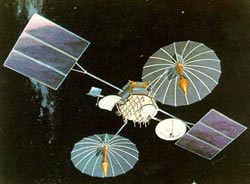TDRS-4 Mission Complete; Spacecraft Retired From Active Service

An Artist Rendering of TDRS-4. <br>Credit: NASA<br>
Launched on March 13, 1989, from onboard Space Shuttle Discovery, TDRS-4 operated in geosynchronous (GEO) altitude at more than 22,000 miles above the Atlantic Ocean region. As part of the spacecraft's end-of-mission activities, its orbit was raised above the congested geosynchronous orbit.
TDRS-4 was forced to retire after the loss of one of three Nickel-Cadmium (24 cell) batteries and the reduction in storage capacity for the two remaining batteries that power the satellite. Retirement for the satellite consisted of excess fuel depletion, disconnecting batteries, and powering down the Radio Frequency Transmitters and receivers so that the satellite is completely and permanently passive. This ensures the satellite will never interfere with other satellites from the radio frequency perspective.
This is the second retirement from within the fleet of TDRS. The fleet of seven remaining satellites operates through a supporting ground system and together they make up the Space Network (SN). The SN provides highly automated, user-driven services supporting customer spacecraft with tracking and data acquisition. The network supports a varied number of missions, including the International Space Station, Hubble Space Telescope, launch vehicles, and a variety of other science missions. The SN also provided primary communication support to the Space Shuttle Project.
“The Space Network spacecraft engineering and operations teams worked together very effectively to execute a practically flawless decommissioning of an incredible satellite,” says Mike Rackley, SN deputy project manager at NASA's Goddard Space Flight Center, Greenbelt, Md. “TDRS-4 made great and important contributions to NASA's human spaceflight and science missions. We will certainly miss her.”
This is the second end-of-mission execution for the fleet of aging first generation TDRS spacecraft. TDRS-4's retirement was preceded by TDRS-1, which was decommissioned and raised to its permanent orbit in June 2010.
A total of six first generation spacecraft were successfully placed into orbit from April 1983 through July 1995, of which four are still active. The spacecraft are approaching the end of their operational life span but they are supplemented by three, second-generation spacecraft.
Together they provide customers with global space to ground communication services.
To continue this critical lifeline, NASA has contracted Boeing to build three additional follow-on TDRS spacecraft, replenishing TDRS-1 and TDRS-4, and expanding NASA's communication services. TDRS-K is scheduled for launch in December of this year followed by TDRS-L in 2013 and TDRS-M in 2015.
The SN is managed by GSFC and its primary ground communications facility is located at the White Sands Complex in Las Cruses, NM. The Human Exploration and Operations Mission Directorate and the Space Communications and Navigation Program at NASA Headquarters fund NASA's Space Network.
Nicole Hagey and Dewayne Washington
NASA's Goddard Space Flight Center, Greenbelt, Md.
Media Contact
All latest news from the category: Physics and Astronomy
This area deals with the fundamental laws and building blocks of nature and how they interact, the properties and the behavior of matter, and research into space and time and their structures.
innovations-report provides in-depth reports and articles on subjects such as astrophysics, laser technologies, nuclear, quantum, particle and solid-state physics, nanotechnologies, planetary research and findings (Mars, Venus) and developments related to the Hubble Telescope.
Newest articles

“Nanostitches” enable lighter and tougher composite materials
In research that may lead to next-generation airplanes and spacecraft, MIT engineers used carbon nanotubes to prevent cracking in multilayered composites. To save on fuel and reduce aircraft emissions, engineers…

Trash to treasure
Researchers turn metal waste into catalyst for hydrogen. Scientists have found a way to transform metal waste into a highly efficient catalyst to make hydrogen from water, a discovery that…

Real-time detection of infectious disease viruses
… by searching for molecular fingerprinting. A research team consisting of Professor Kyoung-Duck Park and Taeyoung Moon and Huitae Joo, PhD candidates, from the Department of Physics at Pohang University…





















